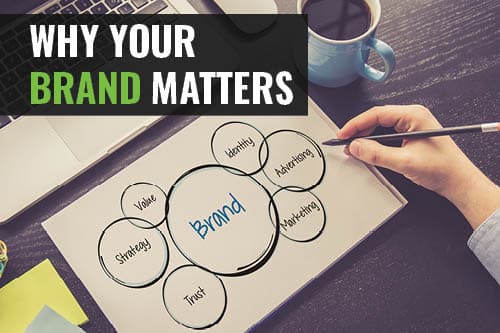Why Your Brand Matters

Your brand is one of your most valuable assets. Although not tangible, it is seen, recognized and shared amongst the public. Your brand should invoke feelings from your customers. It is why shoppers will bypass the competition and choose your product, even if the price is higher. Your favorite sports team has a uniform. People and pets have personalities. Companies and organizations have brands.
Why Consider a Rebrand
Like many things in life, what once seemed interesting may now seem mundane. People outgrow clothing, hairstyles and vehicles, and brands are no different. A brand change may be necessary for a variety of reasons such as changes in customer preferences, new competition, or a change to reflect the direction of the company. A brand change should not be taken lightly or started without an endpoint in sight. Also, we never recommend changing your brand for change’s sake. This could confuse your customers, and as the saying goes, upset your customers, upset your profits. An example of how effective introducing a new brand can be can be found by looking at Apple.
Branding: What Works and What Doesn’t Work
When Apple began as a business in 1976, it focused solely on making computers. As other product lines gained popularity and as their service lines expanded, Apple wanted its brand to reflect the new direction and focus of the company. In 2007, after 31 years of Apple Computers, the decision was made to drop the word ‘computers’ and rebrand simply as Apple. Their business had evolved to include music, entertainment, phones, data storage, tablets and wearables, and their brand needed to represent this new reality to their customers. This decision was not made in a vacuum. They spent time on research to include customer forums, customer feedback, and analyzing data to predict the needs of their most loyal customers.
Just the opposite can happen if you ignore research, data, stakeholders and customers when considering your new brand. Look at what happened to retail giant Gap after their attempt at a rebrand in 2010. Mostly behind closed doors, they developed a new logo and brand and thrust it upon an unsuspecting audience. It was a disaster. It has been estimated the company spent up to $100 million dollars on a new brand that lasted a total of seven days before the company pulled the plug and returned to its original brand and logo. For those keeping score at home, that represents a loss in excess of $15 million a day. The important takeaway is that research, preparation and customer involvement are all critical when rebranding or launching a new brand.
Getting Started with Your New Brand
If you think that your company could benefit from introducing a new brand, what should the next steps be? A new logo or tagline? A new website or new colors? New messaging and imagery? It could be one of these approaches or all of the above. Remember, the goal is to properly capture the personality of your company. When rebranding is complete, the main goal is to ensure the new brand is both authentic and accurate across the brand platform.
Branding should be thought of as a long-term strategy that can yield measurable returns throughout the life of your company. Great brands do things besides stir feelings amongst consumers. It helps to instill loyalty which leads to repeat purchases and positive word-of-mouth advertising. While estimates vary, the current value of the four most recognizable brands in the world, Apple, Google, Amazon and Microsoft, have amassed a value of more than $1.1 trillion in brand equity.
If you believe it’s time to rebrand but aren’t sure how to proceed, we can help. We have worked hand-in-hand with many companies and organizations to rework and strengthen their brands by conducting research, developing strategies and providing direction. Let us show you what a new brand can do for you.

